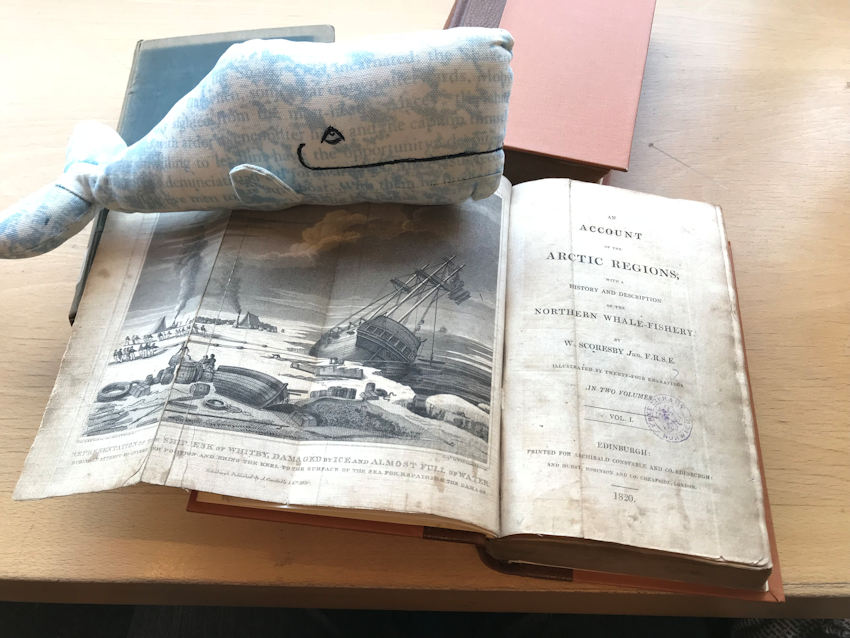
Scoresby’s Arctic. It’s all about the whale!
My co-curator Fiona turned to me and said, ‘This isn’t an exhibition about Moby-Dick you know’. I had bought a copy of the book for possible display in the exhibition, one of my 50 odd versions, the one that laid open flat best. ‘But it is for me’, I replied. ‘I found William Scoresby through Moby-Dick.’
This is all about Moby-Dick for me. I discovered Scoresby because of it. This is why I’ve been so obsessed about his snowflakes – Scoresby is Captain Sleet, and Melville makes fun of him for it, though he respects Scoresby’s whaling knowledge and experience. The more you look (and read around the subject) the more he appears in the book. And Scoresby is our whaling history, not the American three-year sperm whale voyages. British East Coast ports, ships sailing each spring up to the harsh but exotic arctic in the Nineteenth Century to hunt the Right and Bowhead whales, and seals, walrus, polar bear, narwhal, near mythical creatures, hunted, divided up into the commercially valuable or disposable waste.
In 1820 Whitby whaler and scientist William Scoresby Jnr published ‘An Account of the Arctic Regions with a History and Description of the Northern Whale Fishery’. A two-volume work that brought together current knowledge of the Arctic with Scoresby’s experiments and observations from his years as a whaler. He sailed from Whitby every spring to go whaling but also using his learning from his scientific studies at Edinburgh University. Our exhibition at Whitby Museum is celebrating 200 years since the book’s publication (a fact difficult to capture in a snappy title).
1820 Edition of An Account of the Arctic Regions
When I first read Moby-Dick in 2001 I noted that Scoresby was mentioned several times and on researching him I found a finding a fascinating story. I eventually visited Whitby and the museum that houses a display of his scientific instruments and other objects connected with him in 2010. I knew that I wanted to make work about him, his connection to Moby-Dick and his place in British Arctic Whaling, but I knew timing was everything and the time never seemed right.
In October 2018 my husband was working in Yorkshire and we visited Whitby one weekend when I was visiting him. I thought that, with a couple of good exhibitions under my belt and a busy 2019, now might be the time to make an advance to the museum. I emailed the museum explained who I was and what I did and enquired about seeing some of the Scoresby Archive. Got a date, organised another visit to my husband and off I went.
I met Fiona Barnard, the Scoresby Curator, and I looked through and photographed log books and journals, hand written crew lists on scraps of paper. And then there were the drawings! The originals of the illustrations I’d seen in ‘An Account’! I think that one of the reasons that Fiona and I got on so well was the obvious delight and enthusiasm I showed for the work as well as my knowledge of the subject. I’ve been fortunate enough to visit Spitsbergen and some of the places there that Scoresby mapped and illustrated. We shared a table at lunch and as my mind was on literary anniversaries (with Herman Melville’s 200th birthday in 2019 very much the focus of much of my work then) we discussed the possibility of an exhibition on 2020 celebrating 200 years since the publication of Scoresby’s extraordinary book. At Fiona’s suggestion I put together a proposal and two years later here we are!
Utility of Whales. Fabric paint and embroidery
It is early October 2020. I’m writing this sat in the Caffè Nero in Victoria square in Hull, it’s the place I have coffee when I’m in Hull. This is my first trip away since COVID lockdown. Since February I have not been out of my home county of Norfolk. Yesterday I loaded my car up with four large framed textile works and 12 fabric snowflakes in embroidery hoops and delivered them to Whitby museum. At the end of the month our exhibition ‘Scoresby’s Arctic’ opens. It’s not an idea title for an exhibition that covers so much, but I’m still extremely grateful that it’s happening at all (it was a close-run thing). I am co-curating it with Fiona at the museum (a woman whom I have since discovered has infinite patience). It’s been two years in the planning (for the museum at least, it’s been a much longer-term thing for me). It’s the first time I’ve jointly curated and it’s been a great experience. We are both ‘Scoresby enthusiasts’ and that has enabled us to work together very effectively to produce an exhibition celebrating 200 years since Scoresby published his ‘An Account of the Arctic Regions’. It’s a long drive from Norfolk to Whitby, and I chose to break the journey in Hull on my way back. I’ve not been to Hull this year and it feels like a weird second home. The café is next to the currently closed Maritime Museum. The Museum might be shut, but the building itself is gorgeous object in its own right. Being here makes me feel great joy.
I have one more work to produce before the exhibition opens, a simple installation that will consist of a photograph of all 96 of Scoresby’s drawings of snowflakes on tracing paper in 16 pages of 6, layered on a light box and then photographed, printed onto A0 sized Perspex. It’s a bit of a leap in the dark and I am quite anxious about it. I hope it looks good!

